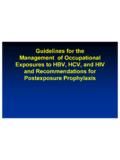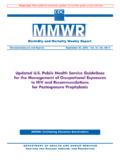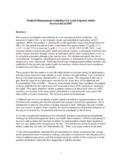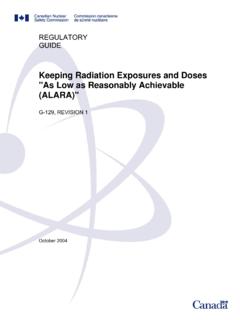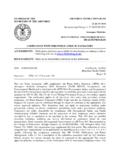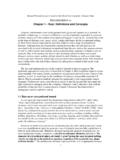Transcription of PREVENTING OCCUPATIONAL HEARING LOSS - Centers for …
1 PREVENTING OCCUPATIONAL HEARING loss A PRACTICAL GUIDE Edited byJohn R. Franks, Mark R. Stephenson, and Carol J. DEPARTMENT OF HEALTH AND HUMAN SERVICESP ublic Health ServiceCenters for Disease Control and PreventionNational Institute for OCCUPATIONAL Safety and HealthDivision of Biomedical and Behavioral SciencePhysical Agents Effects BranchJUNE 1996 Revised OCTOBER 1996 (with minor formatting changes)iiThis document is in the public domain and may be freely copied or reprinted. DISCLAIMERM ention of the names of any company or product does not constitute endorsement by theNational Institute for OCCUPATIONAL Safety and of this and other NIOSH documents are available fromNational Institute for OCCUPATIONAL Safety and HealthPublications Dissemination4676 Columbia ParkwayCincinnati, Ohio 45226-1998To receive other information and other OCCUPATIONAL safety and health issues, call1-800-35-NIOSH (1-800-356-4674), orvisit the NIOSH Home Page on the World Wide Web (NIOSH) Publication No.
2 96-110iiiiiiFOREWORDS ince the publication of A Practical Guide to Effective HEARING Conservation Programs in theWorkplace in 1990, many things have changed, while some have not. Things remaining the sameinclude the HEARING Conservation Amendment to the OSHA Noise Standard. The NIOSH hierarchy of controls endures and can be summarized as: 1) first, prevent or contain the escape ofthe hazardous workplace agent at its source (engineering control); 2) control exposure byrelocating the worker to a safe area (administrative controls); and 3) control the exposure withbarriers between the worker and the hazard (personal protective equipment). This hierarchyunderscores the principle that the best of all prevention strategies is to have no exposure to agentsthat can cause or contribute to HEARING loss . Corporations that have embarked upon buy-quietprograms are moving towards the creation of a workplace where there will be no harmful companies are automating equipment or setting up procedures that can be operated byworkers from a quiet control room free from harmful noise, chemical agents, and heat.
3 When it isnot possible to remove the harmful agent or relocate the worker to a safe area, the worker mustbe protected. In the arena of HEARING loss prevention, protection is a many-faceted process thatincludes exposure assessment, provision of protective equipment, assessment of HEARING withappropriate management and follow-up actions, worker education and training, and continuousevaluation of program things which should have changed have not. There are no requirements for recordingthreshold shifts due to noise exposure, nor is there a national OCCUPATIONAL audiometry register. Without these data, it is not possible to effectively track and evaluate the successes and failures ofoccupational HEARING loss prevention programs. Use of the term OCCUPATIONAL HEARING loss reflects a change since 1990. No longer is noiseconsidered to be the only source of HEARING loss associated with work.
4 Exposures to chemicals,such as aromatic solvents and metals such as lead, arsenic, and mercury can result in HEARING exposures to noise and chemicals can cause more HEARING loss than exposure to eitheragent alone. Vibration and extreme heat are also potentially harmful to HEARING when combinedwith noise. To better respond to the potential HEARING hazards and HEARING loss risk many oftoday s workers face, an additional ingredient ( HEARING loss Prevention Program Audit) hasbeen added to the recommended approach for PREVENTING HEARING emphasis on prevention rather than conservation also reflects a change. The shift fromconservation to prevention is not minor. Conserving HEARING means to sustain the HEARING that ispresent, regardless of whether it is impaired or not. Prevention means to avoid creating hearingloss.
5 Conservation can start when one is first exposed to an OCCUPATIONAL agent that is potentiallyharmful to HEARING . Prevention starts long before the first exposure. Conservation comes from aprogram that is created and imposed. An emphasis on prevention evolves from beliefs that it is notnecessary to suffer an impairment, illness, or injury to hold a job and that it is within one s ownpurview to employ techniques, use behaviors, and rely upon personal protective equipment toprevent impairment, illness, or injury. ivivFinally, there have been substantial changes since 1990 related to the recommended definition ofhazardous noise (85 vs 90 dBA), the use of the equal-energy principle in integrating noiseexposures, and the definition of standard threshold shift (STS). The combined result of suchchanges as these has been to stir the core tenets of HEARING loss prevention.
6 To keep step withthe new directions in HEARING loss prevention, it became apparent that the time had come to recastthe Practical Guide. No guide such as this could be assembled solely by a group of scientists in an agency. So, just aswith A Practical Guide to Effective HEARING Conservation Programs in the Workplace, thisupdated document was prepared by consulting experts in PREVENTING OCCUPATIONAL HEARING loss . They reviewed the prepared materials, and made suggestions for changes, deletions, andadditions. It is our hope that the ideas contained in this guide will provide the inspiration toothers to promote actions needed to protect a vital human function HEARING . Linda Rosenstock, , , National Institute for OccupationalSafety and HealthCenters for Disease Control and PreventionvvEXECUTIVE SUMMARYH earing loss is one of the most pervasive OCCUPATIONAL health problems in America today.
7 Approximately 30 million workers are exposed on their jobs to noise levels or toxicants thatare potentially hazardous to their HEARING . Fortunately, noise-induced HEARING loss can bereduced, or often eliminated, through the successful application of OCCUPATIONAL HEARING lossprevention successful HEARING loss prevention program benefits both the company and the affectedemployee. Employees are spared disabling HEARING impairments and evidence suggests that theymay experience less fatigue and generally better health. Ultimately, the company benefits fromreduced medical expenses and worker compensation costs. In some cases there may be improvedmorale and work existence of a HEARING loss prevention program (even one that complies with governmentstandards) does not guarantee the prevention of OCCUPATIONAL HEARING loss .
8 Experiences withsuccessful HEARING loss prevention programs show that management needs to develop and adhereto certain policies from the start. These policies cover the integration of the HEARING lossprevention program into the company's safety and health program, designation of a key individual(a "program implementor") with ultimate responsibility for the overall conduct of the program,standard operating procedures for each phase of the program, the proper identification and use ofoutside services, and the purchase of appropriate guide, developed by those having long, varied experience in HEARING conservation practices,presents some of the important attributes of successful HEARING loss prevention programs. Concepts and action items are presented in terms of the responsibilities of three groups ofpersonnel: those representing management, those who implement the HEARING loss preventionprograms, and those who are affected by exposure to noise or ototoxic chemicals.
9 Checklists areprovided in the appendices to assist in evaluating HEARING loss prevention programs on astep-by-step presented in the original edition of The Practical Guide, the seven basic components of ahearing loss prevention program consist of: (1) noise exposure monitoring, (2) engineering andadministrative controls, (3) audiometric evaluation, (4) use of HEARING protection devices, (5)education and motivation, (6) record keeping, and (7) program evaluation. To these, we now addan eighth: HEARING loss prevention program loss Prevention Program AuditIdeally, a carefully conducted audit should be performed before any program to prevent hearingloss is put into place, or before any changes in an existing program are made. The audit should beperformed on the system as it exists or doesn t exist. While it is not difficult to conduct an audit,it may require time to assemble the materials necessary to fully answer audit questions.
10 Theviviquestions in Appendix B, Program Evaluation Check List, can serve well for an audit, althoughfor an initial audit the check list should be reordered. It is best to perform the audit from the topdown with administrative issues addressed first. Administrative issues concern corporateresponses to regulations, to good safety and health practices, to the need to develop or modifyprogram policies, to assuring adequate resources, and to providing the necessary authority tothose persons responsible for the day-to-day operation of the program. Aspects of hearingassessment, implementation of engineering and administrative controls, and supervisorinvolvement in the program should be considered. The system for monitoring audiometry andrecord keeping requires close attention since how the records of audiometry and other aspects ofthe program are maintained can make or break the program.










